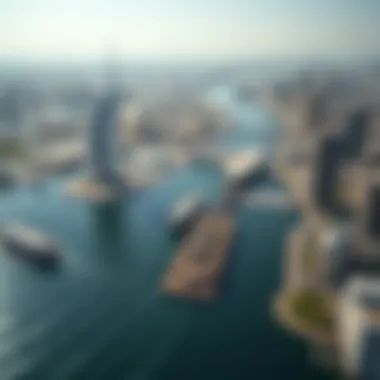Discovering Dubai's Ferry Route: A Detailed Guide


Intro
Dubai is a city that never ceases to amaze with its blend of modernity and tradition, luxury and accessibility. Within this metropolis lies an often overlooked gem in its transport infrastructure: the ferry service. This comprehensive look at the Dubai ferry route isn't just about getting from point A to point B; it embodies a unique aspect of urban mobility in a bustling landscape. The city's rapid development and expanding waterfront areas have made the ferry an integral option for residents, tourists, and investors alike.
In this article, we aim to peel back the layers of the ferry service, diving into its significance beyond mere transportation. We will examine current trends, lifestyle factors associated with neighborhoods along the route, and how these insights forge a deeper comprehension of mobility and real estate in Dubai. With the UAE's push for a smarter transportation framework, understanding the ferry service is crucial for anyone interested in investing or residing in this vibrant city.
Market Trends
Current Property Prices
The relationship between the ferry service and property prices in Dubai is both fascinating and significant. Properties adjacent to ferry terminals often command a premium. This could be due to enhanced accessibility and the scenic views offered by waterfront properties. Recent statistics indicate that areas like Dubai Marina and Jumeirah Beach Residence have seen price hikes of up to 10% over the past year, thanks to their proximity to ferry routes.
Moreover, the trend towards mixed-use developments near ferries is shaping investment opportunities. Properties that combine residential, leisure, and commercial aspects are becoming increasingly favored, aligning with the lifestyle needs of a modern urban dweller. Investors keen on maximizing returns often find that proximity to such transport options raises the overall value of their investments.
Future Market Projections
Looking forward, the outlook for Dubai's real estate market reflects optimism, particularly for areas with ferry access. Experts predict that by 2025, property prices in strategically located waterfront areas may see an overall increase of 15% to 20%. Investors are likely to take note of government initiatives aimed at enhancing marine transport infrastructure, making ferry services more essential than ever in the UAE’s drive towards sustainability.
A notable factor influencing these projections is the anticipated increase in tourist numbers. With Dubai continually positioning itself as a global tourism hub, the ferry route is not just a practical means of transport but also a tourist attraction, offering views of iconic landmarks from a unique vantage point.
Lifestyle Insights
Neighborhood Highlights
The areas served by ferry routes tend to be vibrant and diverse, with each possessing unique community characteristics. For instance, Dubai Marina is not just a prime property hotspot; it’s enriched with dining, retail, and leisure options, making it a hive of activity. On the other hand, areas like Al Jaddaf encapsulate the local charm while providing easy transport access, appealing to both residents and tourists.
The ferry route also connects lesser-known gems, where residents can find hidden cafes and art galleries, giving them a slice of local culture that contrasts sharply with the glitz of upscale developments.
Community Amenities
Being near a ferry stop often enhances quality of life, offering residents amenities like parks, recreational spaces, and easy access to central hubs. Many waterfront communities include amenities that focus on outdoor activities, which enrich the lifestyle for families and young professionals alike.
Public spaces in these neighborhoods are often well-maintained and popular, thus encouraging community engagement. Furthermore, the ease of commuting provided by ferry services reduces the carbon footprint, aligning with sustainability goals. This has become increasingly relevant to millennials and Gen Z, who prioritize eco-friendliness in their living choices.
Pro tip: Investing in properties close to ferry routes can yield long-term benefits both financially and in terms of lifestyle.
For more insights on Dubai’s transport infrastructure and property market, consider visiting Wikipedia on Dubai's transportation and Dubai Land Department for real estate data.
Preamble to Dubai's Water Transport System
Dubai's water transport system has evolved as a cornerstone of the city’s comprehensive urban infrastructure. Given the rapid development and population growth in this vibrant metropolis, efficient transportation has become more crucial than ever. Unlike many regions, where transportation options might be limited to land routes, Dubai has embraced the waterways, creating a vital network that not only enhances accessibility but also offers a unique perspective on the city.
The ferry services in particular bring various advantages to both residents and tourists. These vessels are not simply a means of transport; they represent a lifestyle choice amid the hustle and bustle of urban living. Reducing road congestion is one of the key benefits of the ferry system. They provide an alternative for those who wish to avoid the lengthy drives or the frustrations of traffic jams often found on Dubai’s roads.
The Role of Ferries in Urban Mobility
Ferries play an essential role in enhancing urban mobility within Dubai. They connect seamlessly with various districts, which is particularly significant in a city characterized by its sprawling nature. One can easily hop on a ferry at Dubai Marina and enjoy a scenic glide over the water to Al Ghubaiba, taking in the stunning skyline views along the way.
By integrating these ferry services into the unified transport system, Dubai is taking strides toward a more sustainable urban environment. As the city continues to grow, public transport options like ferries reduce the reliance on cars, making it an attractive feature for both potential investors and residents. Moreover, the charm of the waterway provides an experience that defies the mundane nature of regular commutes, captivating everyday travelers.
To further illustrate the significance of water transport, it’s worth noting that this system isn’t just about convenience; it’s about creating an experience. Travelers can enjoy the openness of the sea, refreshing breezes, and the beauty of Dubai from a different angle. This isn’t just transport—it’s part of an evolving lifestyle choice, appealing to both those looking for a quick commute and those yearning for an additional layer of enjoyment.
As we delve into the specifics of the ferry services in Dubai, we’ll explore operational schedules, specific routes, and a wealth of other aspects that highlight the unique benefits of this mode of transport. Travelers can enjoy more than just transit; they can relish moments that enrich their journey in one of the world’s most dynamic cities.
Overview of Dubai Ferry Services
Dubai's ferry system is not just a means of transport; it's a lifeline that illustrates how this rapidly growing metropolis values efficiency and eco-friendliness in urban mobility. As one hurries through the city, the undulating waterways can easily be overlooked, yet they connect some of the most vital points in the urban landscape. The ferry services in Dubai offer extensive routes that serve both residents and tourists alike, and their significance transcends mere convenience.
Understanding these services is crucial for anyone considering a move to the city or investing in real estate. With the widespread expansion of ferry routes, especially in areas undergoing major development, investors and homeowners can anticipate a boost in property values as accessibility increases.
Types of Ferry Vessels
The fleet of ferries operating in Dubai is diverse, reflecting both contemporary needs and aesthetic sensibility. These vessels come in different shapes and sizes, accommodating various passenger capacities and preferences.
- Traditional Abras: These small wooden boats are steeped in history, providing an iconic transport option that remains popular. They offer a unique feel, allowing riders to experience the city’s heritage firsthand.
- Modern Ferries: Equipped with air conditioning and comfortable seating, these vessels cater to a more contemporary audience. They’re designed for longer routes and larger passenger volumes, making them a reliable choice for daily commuters.
- Luxury Yachts: For those looking to splurge, luxury yachts are available, offering a more opulent travel experience. These yachts feature exquisite onboard amenities, turning a simple ferry ride into an unforgettable experience.


Each type of vessel caters to different needs and preferences, ensuring that the ferry service remains inclusive.
Operational Schedule
Timing is critical, especially in a bustling city like Dubai. The ferry services operate with a carefully planned schedule that aligns with peak commuting hours, ensuring convenience:
- Morning Runs: Starting early to accommodate commuters heading to work, ferries leave at frequent intervals.
- Midday Services: Reduced frequencies during lunch hours are suitable for tourists exploring sights at a leisurely pace.
- Evening Schedule: Services ramp up again in the evening to cater to those leaving work and socializing in the city.
Moreover, real-time tracking apps help passengers stay updated on ferry timings, providing a seamless traveling experience.
Epilogue
In a city renowned for its luxurious lifestyle, the Dubai ferry services offer a blend of traditional charm and modern efficiency. As infrastructure developments continue and public awareness grows, these services have the potential to elevate urban mobility, attract new investments, and enhance the overall quality of life. Understanding the range of ferry vessels and their operational schedules is essential for anyone looking to navigate life in Dubai more effectively.
Key Ferry Routes in Dubai
The ferry routes in Dubai represent a vital thread in the city's intricate tapestry of transport options. Not only do they facilitate easy movement across water, but they also connect various key locations, making commutes seamless for both residents and tourists. These routes stand as a testament to Dubai's commitment to enhancing mobility while showcasing some breathtaking views of the skyline and waterfront.
Dubai Marina to Al Ghubaiba
The** Dubai Marina to Al Ghubaiba** route is arguably one of the busiest commuter paths, weaving through a picturesque landscape. It allows passengers to glide past opulent yachts and modern architecture that define the Marina. The ferry ride from Dubai Marina takes roughly 40 minutes, providing an efficient alternative to traveling by road, especially during peak hours when traffic can be a real headache.
This route offers a scenic escape while also being functional. As riders sip a coffee on board, they can soak in views of the Jumeirah Beach Residence and the iconic Burj Al Arab in the distance. The integration of this route adds value for investors, as properties near the ferry terminals are likely to see heightened demand, leading to surging property values.
Al Jaddaf to Festival City
This route connecting Al Jaddaf to Festival City is a gem for both locals and visitors. The ride across Dubai Creek is not only practical for those headed to the Festival City Mall, but it also serves as an enjoyable journey through a rich part of Dubai's history. The trip takes about 20 minutes, making it longer than a car ride during normal traffic but much more immersive.
Onboard, passengers are treated to stunning views of the historic Dubai Creek, alongside the modern facades of Festival City that loom just ahead. This blend of past and present is particularly appealing to investors looking at real estate opportunities. Properties near Al Jaddaf, which were once seen as slightly out of the way, are gaining interest due to this convenient ferry service. Therefore, the ferry's existence enhances the attractiveness of the location for potential residents and businesses alike.
The Creek Cruise
The Creek Cruise is less about heavy commuting and more about leisure, offering a unique vantage point of the city. While it traditionally caters to tourists, this route is gradually becoming a staple for residents seeking a slice of tranquility amidst the hustle and bustle.
The journey typically spans around 30 minutes, moving along the iconic Dubai Creek, presenting both a historical and modern experience. Travelers can witness the juxtaposition of old Dubai's charm with the skyline's modernity.
"Taking the Creek Cruise isn't merely about getting from point A to point B—it's about experiencing the heart and soul of Dubai as you travel through time and architecture."
Passing by sites such as the Dubai Museum and the Gold Souk, this route cultivates a sense of belonging and proud heritage. For real estate developers, the popularity of this cruise enhances the value of properties along the creek. It underscores the notion that accessibility to water transport not only makes living more convenient but enriches the lifestyle, making these areas more desirable.
Benefits of Using Ferry Services
The ferry services in Dubai stand out not just as a means of transport, but as a pivotal component of the city's urban mobility framework. With an ever-increasing population and a burgeoning real estate sector, understanding the benefits of using ferries can greatly influence the decisions of investors, developers, and residents alike. This overview presents various elements that underscore why ferry services have become a popular choice for navigating the city.
Reduced Travel Time
Navigating the bustling streets of Dubai can sometimes feel like a game of chess, where every move counts. One of the primary advantages of utilizing ferry services is the significant reduction in travel time. For instance, the ferry commute between Dubai Marina and Al Ghubaiba can be quicker than road alternatives, especially during peak hours when traffic congestion can turn a short journey into a lengthy ordeal.
In addition to avoiding traffic, ferries have their own dedicated routes that facilitate smoother travel. Here’s how:
- Direct Access: Ferries often connect key commercial and residential areas, allowing passengers to bypass the city's major roadways.
- Time Efficiency: Scheduled ferry routes mean predictability; commuters know when to expect departures and arrivals, making planning much easier.
- Reduced Hassle: For individuals unfamiliar with the city's road rules or driving constraints, hopping on a ferry can be a hassle-free alternative.
Finding oneself stuck in traffic might leave one grumbling, but a breezy ferry ride provides not only swifter transportation but also the opportunity to enjoy the scenic beauty along the waterfront.
Scenic Experience
Traveling by ferry in Dubai is much more than just a means to reach a destination; it’s an experience that tantalizes the senses. Imagine relaxing on a deck, with a gentle breeze, surrounded by the stunning skyline that Dubai is renowned for. Ferries offer a unique vantage point that simply isn’t available on land. Here’s what makes the ferry ride a scenic delight:
- Panoramic Views: Passengers can behold the longevity of the Burj Khalifa, the sprawling Jumeirah Beach, and the architectural marvels along the Dubai Creek—all from the comfort of their seats.
- Nature Connection: The sound of waves and the smell of the ocean are invigorating. Unlike urban noise, the calm of water provides a refreshing contrast.
- Cultural Insight: Many ferry routes pass traditional landmarks, offering glimpses into the city’s cultural landscape. It’s an ideal way for tourists to appreciate the city's rich heritage while enjoying modern luxuries.
"Traveling by ferry isn't just about getting from point A to B; it's about appreciating the journey itself."
In a place known for its towering skyscrapers and man-made wonders, the ferry experience stands as a reminder of the natural beauty that coexists with the urban landscape.
Through reduced travel time and a unique scenic experience, ferry services provide critical benefits that enhance the overall quality of transportation in Dubai. These advantages play a significant role in shaping perceptions and decisions among investors and residents, amplifying the allure of waterfront living.


Accessibility and Convenience
Accessibility and convenience are indispensable aspects when examining the Dubai ferry system. This segment of the city's transport network not only serves as a means of transit but also enhances the overall urban mobility experience for its users. With the rapid urbanization of Dubai, the demand for transport solutions that can efficiently connect various key areas has significantly increased. Ferries are uniquely positioned to meet this demand, offering a blend of practicality and scenic enjoyment.
Connecting Key Points in the City
The ferry service in Dubai directly links significant landmarks and bustling districts around the city. Think about how daily commuters and tourists navigate the vibrant urban layout. They often find themselves racing against time to get to meetings or explore attractions. The efficiency that ferries provide can make a noticeable difference. For instance, the route from Dubai Marina to Al Ghubaiba cuts through some of the city’s hidden gems, allowing passengers to catch glimpses of the skyline that they wouldn’t see from a taxi or bus.
Consider the following points on how ferries connect vital points in the city:
- Tourist Hotspots: The ferry route touches locations such as Festival City and Al Jaddaf, making it easier for visitors to access major attractions without the fuss of road traffic.
- Residental Areas: Key residential neighborhoods adjacent to ferry routes see a natural increase in foot traffic as families appreciate the ease of access to the rest of the city.
- Business Districts: The ferry serves business hubs, equally appealing for those heading to work or attending meetings. The ability to glide across the water instead of being stuck in traffic is a blessing for many.
The transport mode encourages a healthier work-life balance, as it promotes leisure travel that is not entwined with stress. It's worth noting that, while ferries are a splendid option, those who rely solely on them must continue to consider their schedules and the timing of ferry departures—making them plan accordingly.
Integration with Other Transport Modes
Ferries in Dubai do not operate in isolation. They are part of a larger transport ecosystem, integrating seamlessly with other services like the Dubai Metro and bus networks. This interoperability is crucial for ensuring that passengers can transition smoothly from one mode of transport to another without hassle.
- Metro Links: Several ferry terminals are located near metro stations. For example, the Al Ghubaiba ferry station is conveniently adjacent to the Al Ghubaiba Metro Station. This allows riders to hop off the ferry and onto the metro within minutes.
- Public Transportation: Many bus routes are designed to complement ferry schedules, helping to whisk passengers from the ferry terminals to their ultimate destinations.
- Ride-Sharing Services: Users often employ ride-sharing applications like Uber or Careem to cover the last mile after disembarking from their ferry. This flexibility further emphasizes the adaptability of the ferry system within the transport framework.
This interconnected approach not only minimizes travel time but also encourages more residents and visitors to opt for ferries over private vehicles, thereby contributing to reducing congestion and pollution—an essential consideration for the sustainability goals of Dubai.
In summary, accessibility and convenience through the Dubai ferry system represent significant advantages that foster urban mobility, promoting ease of travel across the city’s vibrant landscape.
Real Estate and the Ferry Route
The interconnection between real estate and the ferry route in Dubai is a significant aspect that offers unique insights for various stakeholders, particularly investors, realtors, renters, developers, and homeowners. The ferry system does not merely serve as a mode of transportation; it shapes the urban landscape and impacts property dynamics in ways that are both profound and multi-faceted. Understanding this relationship allows for a more nuanced approach to property investment and development in this vibrant city.
Impact on Property Values
The presence of ferry services can be likened to a golden ticket for property values. Proximity to ferry stations may elevate the desirability of a location, which inevitably leads to an increase in property values. This phenomenon is especially notable in areas like Dubai Marina and Al Ghubaiba, where views of stunning waterways paired with easy transport add a premium.
- Accessibility Boost: With ferry routes connecting key urban areas, properties nearby often see a surge in demand. Those beautiful waterfront apartments that once sat on the market can suddenly become hot properties.
- Lifestyle Appeal: The appeal of living near water cannot be overstated. Many buyers and renters gravitate towards locations that promise a scenic lifestyle, and ferry access enhances this allure.
- Market Trends: Historical data may indicate that properties in proximity to ferry routes consistently outperform the market average. As demand rises, sellers are naturally inclined to increase their asking prices, making these areas lucrative for investment.
It’s not just about the views; the convenience and lifestyle enhancements that ferry access brings to a neighborhood can solidify its status as a sought-after locale.
Attracting Investors and Residents
Investors and potential residents are increasingly drawn to areas serviced by ferry routes, viewing them as not just a place to live, but as a lifestyle choice. The ferry’s role in promoting urban mobility opens gateways for real estate developers to frame their projects around this convenience.
- Investment Viability: Investors view properties near ferry routes as prime real estate, often leading to higher appreciation rates. The long-term potential of such investments is promising as the city continues to expand.
- Diverse Living Options: The availability of ferry routes attracts a broader spectrum of residents, including young professionals, families, and retirees, all of whom seek easy access to Dubai’s waterfront. This diversification influences the types of developments that arise near ferry stops.
- Community Development: The integration of ferry services within a neighborhood does more than attract residents – it fosters community building. With cafes, shops, and parks often located near these transport hubs, they become lively spots for interaction among residents.
In summary, proximity to ferry routes is becoming a cornerstone for real estate in Dubai. It signifies not only value but also quality of life. As Dubai’s transport system expands, continuing to invest in properties located near these networks might just be the key to securing future profitability in the ever-evolving real estate market.
"The real estate landscape in Dubai appears to be in sync with its water transport evolution, showcasing how mobility influences desirability."
Consider checking out resources such as Wikipedia, Britannica, and insightful discussions on Reddit regarding current property trends linked to ferry routes. This will provide deeper context and assist in understanding the broader implications of this relationship.
User Experience and Amenities
When it comes to public transport, especially in a city as bustling as Dubai, the experience of the user plays a big role. The ferry services not only offer transportation but also a unique way to experience the city from the water. Being on board a ferry while sailing past Dubai’s iconic skyline can make a routine commute feel like a mini-vacation. This section will dive into the specific amenities available on the ferries and the comfort and safety standards upheld to enhance the overall experience of passengers.
Facilities on Board
On any given ferry ride in Dubai, passengers can take advantage of various facilities designed to cater to their needs. The amenities are more than just an afterthought; they serve to improve not just the journey but also the overall perception of the ferry experience.
- Spacious Seating: The ferries come equipped with wide, comfortable seating arrangements, allowing passengers to stretch out and relax. This space not only prevents discomfort during longer trips but also gives a sense of openness, essential for those who might feel claustrophobic in crowded buses or cars.
- Wi-Fi Connectivity: Many ferries offer free Wi-Fi, enabling passengers to connect with the world, whether they’re catching up on work emails or sharing their scenic views on social media. It's a small touch but one that is hugely appreciated in today’s digital age.
- Refreshments and Snack Bars: Some routes offer snack bars that sell light refreshments, allowing passengers to grab a quick bite. This feature is particularly useful for those commuting during lunch hours or for tourists wanting to make the most of their time on the water.
- Viewing Decks: Open-air viewing decks set the ferries apart from other forms of transport, giving passengers the opportunity to soak up the sun or enjoy a cool breeze. It’s a perfect opportunity to capture stunning photographs of Dubai’s skyline.
Comfort and Safety Standards
When it comes to commuting, comfort and safety should never be compromised. Dubai’s ferry services have embraced this philosophy, making strides to ensure a pleasant ride for all.
- Comfortable Climate Control: Each vessel is fitted with an effective climate control system. Air conditioning ensures that even on the hottest days, passengers can enjoy a comfortable ride without breaking a sweat.
- Safety Equipment: Safety doesn’t take a backseat on these ferries. Life jackets, emergency signals, and well-marked escape routes are standard features. Passengers can feel secure knowing that the crew is trained for emergencies, and safety drills are regularly conducted.
- Surveillance Systems: Each ferry is equipped with modern surveillance systems, ensuring passenger safety at all times. This technology helps provide peace of mind as you cruise the waterways.
- Professional Staff: Crew members are not just there to operate the ferries; they are trained in customer service and emergency response, enhancing the ride experience while ensuring passengers feel safe and attended to.
Overall, the user experience aboard Dubai's ferries is designed with attention to detail, fostering an inviting environment. The combination of quality amenities, comfort features, and safety protocols positions the ferry as an attractive mode of transport for both residents and tourists alike.


"The vessel’s amenities reflect the sophisticated nature of Dubai, capturing the essence of luxury even in public transport."
For more information about public transport regulations in Dubai, visit Dubai's Roads and Transport Authority.
As ferry services continue to grow, it will be interesting to watch how these amenities evolve to cater to diverse passenger needs.
Challenges and Limitations
The ferry system in Dubai contributes significantly to the city's transport network, yet it is not without its own set of challenges and limitations. Understanding these factors is essential for anyone considering the intricacies of urban water transport. This section examines issues related to infrastructure and weather that can impact ferry services, ultimately influencing the user experience and operational efficiency.
Infrastructure Constraints
One of the most pressing challenges that the Dubai ferry system faces lies in its infrastructure. While the city boasts state-of-the-art developments, the integration of ferry services requires suitable docking facilities and maintenance hubs. Many existing jetties need modern upgrades to accommodate larger vessels or to allow smoother transitions for passengers from land to water. For instance:
- Limited docking space during peak hours can lead to delays.
- Some terminals are under-maintained, affecting usability and safety.
- Inadequate signage and amenities can leave first-time users puzzled.
Moreover, the layout of Dubai's waterfront areas often restricts the planning and expansion of ferry routes. As the city continues to grow vertically, these constraints may hinder the ferry services’ ability to expand and adapt to changing demands. Consider the impact this might have on real estate visibility; property developers and investors need to contemplate how such logistical hurdles can affect potential clientele who prioritize seamless transport options.
“Infrastructure investments are the backbone of any successful transport system, and inadequate facilities can diminish the overall ferry experience.”
Weather-Related Issues
Dubai's climate poses another challenge for ferry operations. While the sun-soaked skies may seem inviting, harsh weather conditions, including strong winds and inclement weather, can disrupt ferry schedules. These issues might lead to:
- Cancellations or delays caused by rough seas.
- Safety concerns for passengers who require reliable travel options.
- Increased operational costs incurred during necessary weather precautions.
Particularly during the summer months, extreme heat can also lead to uncomfortable travel conditions within ferry vessels if air conditioning systems are not adequately maintained. This discomfort can decrease the appeal of ferry rides among potential users.
Considering these factors, stakeholders need to address weather-related challenges efficiently. By assessing forecasts and making use of innovative weather forecasting technologies, ferry services can provide more reliable schedules and ensure a safer travel environment.
To sum it up, while the ferry services in Dubai are a vital part of the city’s transport network, existing infrastructure issues and weather constraints can impose notable limitations on their operation. Understanding these challenges is crucial for investors, realtors, renters, and homeowners who are closely monitoring changes in Dubai's urban landscape as they relate to mobility and accessibility.
For more insights into Dubai's transportation framework, feel free to check out these resources: Dubai Water Transport, and Government of Dubai.
Future Developments in Ferry Services
The evolution of ferry services in Dubai marks a fascinating chapter in the city’s continuous journey towards enhancing its public transportation system. As Dubai continues to thrive as a global hub, the importance of adapting and upgrading its ferry services cannot be overstated. This section explores the prospective developments that aim to reshape water travel in the city.
Planned Expansion of Routes
In recent times, the push for an expansion of ferry routes in Dubai has gained significant momentum. The current network includes a handful of popular routes, but there is potential to cover more ground. New ferries could potentially connect remote areas like Jumeirah Beach to key business districts, further solidifying the role of ferries as a staple in urban transport. Potential routes being considered might include:
- Al Wasl to Bluewaters Island: Opening this route would provide easy access to entertainment spots, not just for tourists, but also for locals.
- Nakhl, across the Creek: Increased accessibility between buzzing markets and residential areas can enhance community engagement.
- Palm Jumeirah to Downtown Dubai: This move would not only lessen road traffic but could also become a more pleasurable commute, sailing through mouthwatering landscapes.
This expansion serves multiple purposes; it alleviates road congestion, reduces travel time, and provides a scenic approach to city navigation.
Technological Innovations
The integration of modern technology in ferry services is another key consideration for the future. With rapid advancements in maritime technology, there are several innovations that could substantially improve the ferry experience.
One area ripe for enhancement is automation. Automated ferry systems could ensure timely departures and arrivals without errors, thus enhancing efficiency.
Additionally, eco-friendly vessels are becoming increasingly important in today's age of environmental consciousness. Innovations such as hydrogen fuel technology or electric propulsion systems could minimize carbon emissions, offering a greener alternative to traditional ferries.
Moreover, the implementation of smart tech like real-time tracking systems and mobile apps for ticketing and schedules could vastly improve user experience. Passengers would be empowered to monitor ferry locations, plan journeys more effectively, and save time through targeted updates.
Closure
In summarizing the integral role of the ferry system within Dubai's transport network, it becomes evident that this mode of travel offers not only a unique experience but also practical benefits that align with the city’s rapid growth and urban planning goals. Ferries provide a scenic and efficient avenue for travel that often bypasses the congested roadways while showcasing the stunning vistas of the coastline and skyline.
The Future of Water Transport in Dubai
As Dubai continues on its path of progressive development, the future of water transport, particularly ferry services, looks promising. Several factors contribute to this optimism:
- Planned Expansion of Routes: Authorities have laid out ambitious plans to enhance existing routes and introduce new ones. This expansion could further connect underserved areas, promoting equitable access to water transport.
- Technological Innovations: The integration of smart technologies into ferry services is poised to significantly improve operational efficiency. This may include real-time tracking for passengers, advanced ticketing systems, or even eco-friendly vessels that contribute to the city’s sustainability goals.
- Increase in Demand: With a growing population and an influx of tourists, the demand for alternative transport modes is on the rise. Water transport offers a distinctive solution that also capitalizes on Dubai’s waterfront appeal.
To put it succinctly, the ferry system stands at a pivotal juncture, with potential to reshape how residents and visitors navigate the urban landscape. As investments pour in and innovations emerge, the very fabric of Dubai's transport network may be woven with more threads of water, connecting communities and enhancing the quality of life.
"Water transport is not just a method of moving from point A to B; it is an experience that reflects the culture and spirit of a city."
The fusion of scenic pleasure and practical connectivity through ferry services highlights their importance in urban mobility. For investors and stakeholders, recognizing this evolution in transportation highlights opportunities not just in real estate adjacent to ferry routes, but also in developing services and amenities that would facilitate this shift towards a more integrated transport solution in the grand tapestry of Dubai's evolving landscape.











